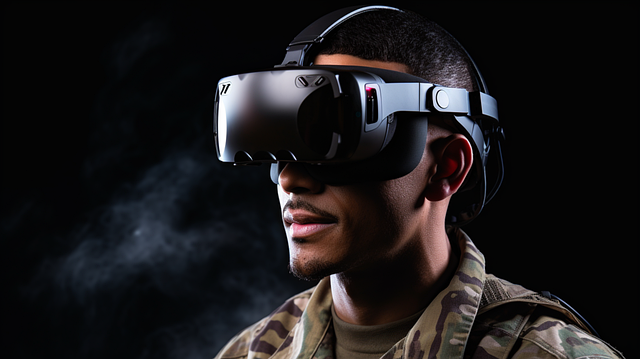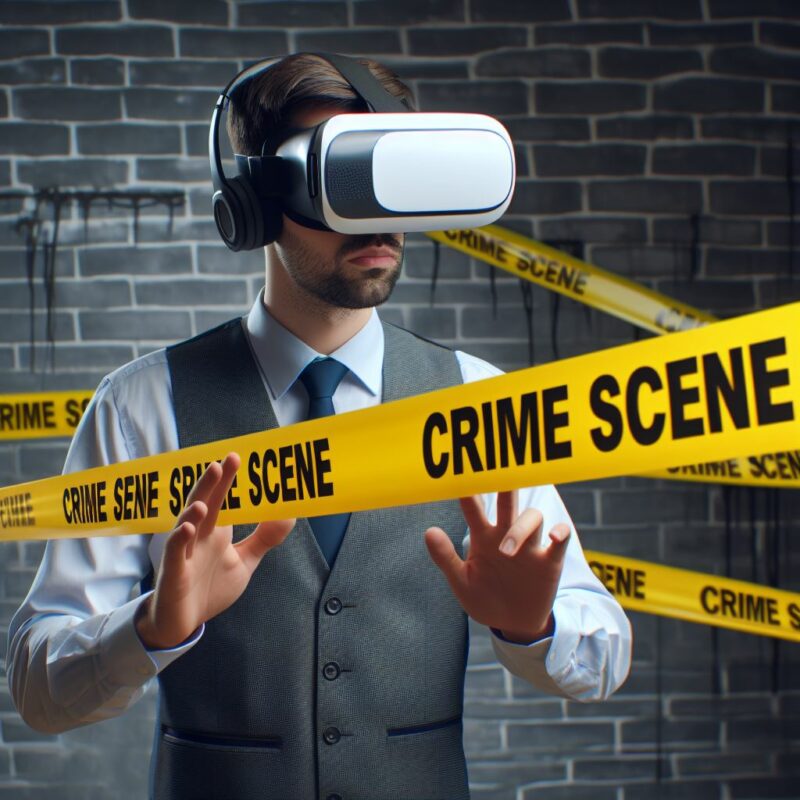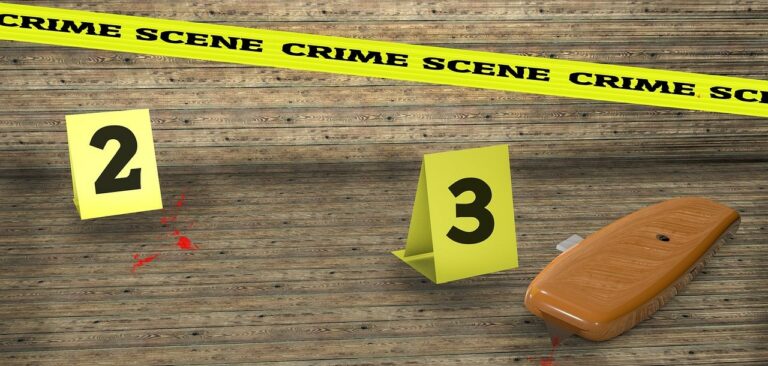Exploring the Virtual Reality Technology in Crime Scene Investigations
The Virtual Reality Technology is a promising innovation that can transform crime scene investigations. It allows users to experience realistic, computer-generated environments that can recreate crime scenes, train investigators, and foster teamwork among them. VR simulations are a unique and powerful tool for advancing the field of forensic science.
Overview of The Virtual Reality Technology
VR technology creates immersive, three-dimensional environments that users can experience and interact with using specialized hardware and software. Users wear VR headsets or goggles that transport them into digital worlds. There, they can explore, manipulate objects, and engage with their surroundings as if they were really there.
Virtual Reality simulations use advanced computer graphics, motion tracking, and sensory feedback systems to mimic real-world environments with high accuracy. This technology has many uses in different industries, such as entertainment, education, healthcare, and military training.
Importance of VR Technology in Crime Scenes
Virtual reality (VR) simulations have immense potential to revolutionize crime scene investigations. They can transform traditional methods of collecting, analyzing, and reconstructing evidence. By recreating crime scenes in virtual environments, investigators can gain new insights, test hypotheses, and visualize complex scenarios with unprecedented clarity.
VR simulations offer several key advantages over conventional approaches to crime scene investigations:
- Enhanced Visualization: VR technology enables investigators to explore crime scenes from multiple perspectives, allowing for a more comprehensive understanding of spatial relationships and potential evidence.
- Accurate Reconstruction: By digitally recreating crime scenes, investigators can reconstruct events with precision, identifying crucial details and uncovering hidden clues that may have been overlooked.
- Immersive Training: VR simulations provide a safe and controlled environment for training new investigators, allowing them to practice crime scene analysis and evidence collection techniques in realistic scenarios without compromising the integrity of actual crime scenes.
- Collaborative Analysis: VR technology facilitates collaboration among investigative teams by enabling them to share and interact with virtual crime scene reconstructions in real time, regardless of their physical location.
In this blog, we will explore how VR technology can be used in crime scene investigations. We will examine how it can help with crime scene reconstruction, training and education, collaboration and communication, and future trends and innovations.

Understanding Virtual Reality Simulations
Virtual Reality (VR) technology is an advanced computer simulation that creates a three-dimensional, interactive environment for users. By using specialized hardware such as VR headsets or goggles, users can feel like they are in the virtual world, where they can explore and interact with objects and surroundings as if they were real. VR technology achieves this immersive experience by combining high-quality graphics, motion tracking, and sensory feedback.
The key to VR technology is creating a realistic illusion of reality by showing users computer-generated images and sounds that mimic real-world environments. The VR headset follows the user’s head movements in real-time, changing the visual and auditory cues accordingly to keep the illusion of presence and immersion. Moreover, some VR systems use hand-held controllers or motion-tracking devices to let users interact with virtual objects and change their surroundings within the digital environment.
Introduction of VR Technology Used in CSI
VR simulations are a powerful tool for crime scene investigations, as they can digitally reconstruct complex crime scenes in a virtual environment. This gives investigators unprecedented insight into how the crime was committed, where the evidence is located, and what scenarios are possible based on the spatial relationships.
Investigators can walk through VR simulations of crime scenes, interact with objects and evidence, and examine details from different perspectives. This immersive approach helps them discover new clues, test hypotheses, and visualize the dynamics of the crime scene with more accuracy and precision than traditional methods.
Benefits of VR Technology in Crime Scenes
The use of VR technology in recreating crime scenes offers numerous benefits to investigators and forensic experts:
- Enhanced Visualization: VR simulations provide a detailed and immersive visualization of crime scenes, allowing investigators to explore every aspect of the scene with unprecedented clarity and detail.
- Accurate Reconstruction: By recreating crime scenes in virtual environments, investigators can reconstruct events with precision, accurately depicting the spatial layout and sequence of activities that occurred during the commission of a crime.
- Dynamic Interaction: VR simulations enable investigators to interact with virtual objects and evidence, allowing for dynamic exploration and analysis of crime scenes in real time.
- Safe and Controlled Environment: VR simulations provide a safe and controlled environment for investigators to conduct experiments, test hypotheses, and simulate various scenarios without disturbing or compromising the integrity of actual crime scenes.
- Training and Education: VR simulations offer a valuable training tool for aspiring investigators and forensic professionals, allowing them to practice crime scene analysis and evidence collection techniques in realistic scenarios.
VR technology can greatly benefit crime scene investigations by enabling investigative teams to analyze evidence more accurately and efficiently, and by supporting the justice system in resolving criminal cases.
Examples of VR applications in Recreating Complex Crime Scenes
VR technology has been successfully applied in a variety of criminal investigations to recreate complex crime scenes and scenarios:
- Homicide Investigations: VR simulations have been used to reconstruct homicide scenes, allowing investigators to visualize the positioning of victims, weapons, and other evidence, and analyze the dynamics of the crime.
- Traffic Accidents: VR technology has been utilized to recreate traffic accidents and collisions, enabling investigators to assess factors such as vehicle speed, trajectory, and impact forces, and determine the cause of the accident.
- Arson Investigations: VR simulations have been employed in arson investigations to recreate fire scenes and analyze the spread and progression of the fire, identifying potential ignition sources and accelerants.
- Burglary and Theft: VR technology has been applied in burglary and theft investigations to recreate crime scenes and identify points of entry, exit, and access, assisting investigators in understanding the perpetrator’s actions and intentions.
Advantages of VR Technology vs Traditional Methods of Crime Scene Reconstruction
VR simulations offer several advantages over traditional methods of crime scene reconstruction:
- Accuracy and Precision: VR simulations provide investigators with a highly accurate and detailed representation of crime scenes, enabling them to analyze spatial relationships and evidence placement with precision.
- Flexibility and Interactivity: VR simulations allow investigators to interact with virtual objects and evidence, enabling them to manipulate and examine the scene from different perspectives, test hypotheses, and explore alternative scenarios.
- Safety and Preservation: VR simulations provide a safe and controlled environment for investigators to conduct experiments and simulations without disturbing or compromising the integrity of actual crime scenes.
- Training and Education: VR simulations offer a valuable training tool for aspiring investigators and forensic professionals, allowing them to practice crime scene reconstruction techniques in realistic scenarios, enhancing their skills and expertise.

VR technology is a game changer and can transform the way crime scenes are reconstructed, giving investigators a clear and precise way to visualize, analyze, and interpret complex evidence. With VR simulations, investigative teams can boost their skills, increase the reliability of their analysis, and ultimately, promote justice in criminal cases.
Enhancing Training and Education
Training and education are crucial for crime scene investigators, as they equip them with the necessary skills and expertise to effectively analyze and process crime scenes. Virtual Reality (VR) simulations offer an immersive and unique training experience that enables new investigators to practice evidence collection and crime scene analysis techniques in realistic scenarios, with many advantages over traditional training methods.
VR simulations create a dynamic and interactive training environment for new investigators, where they can gain practical experience with crime scene investigations without the restrictions and challenges of real-world scenarios. Through VR-based training programs, new investigators can learn investigative techniques, protocols, and procedures, sharpening their skills and boosting their confidence in their abilities before facing actual crime scenes.
The immersive nature of VR environments offers several key benefits for training new investigators:
- Realistic Scenarios: VR simulations recreate realistic crime scene scenarios, allowing new investigators to experience the challenges and complexities of real-world investigations in a controlled environment.
- Hands-On Experience: VR simulations provide new investigators with hands-on experience in collecting evidence, documenting crime scenes, and conducting forensic analysis, allowing them to practice essential skills and techniques in a safe and controlled setting.
- Immediate Feedback: VR-based training programs can provide immediate feedback and guidance to new investigators, allowing them to learn from their mistakes and improve their performance in real time.
- Repeatable Exercises: VR simulations allow new investigators to repeat training exercises and scenarios as needed, enabling them to reinforce their learning and improve their proficiency over time.
- Cost-Effective Training: VR-based training programs offer a cost-effective alternative to traditional training methods, eliminating the need for expensive equipment, materials, and resources associated with live training exercises.
Case Studies or Examples of VR-based Training Programs
Several organizations and institutions have developed VR-based training programs for crime scene investigators, providing valuable insights and experiences for new investigators:
- The Federal Bureau of Investigation (FBI) has developed VR-based training simulations for its forensic science training programs, allowing new investigators to practice crime scene analysis and evidence collection techniques in realistic scenarios.
- The National Institute of Justice (NIJ) has funded research projects exploring the use of VR technology in forensic science education and training, including developing VR-based crime scene investigation simulations for law enforcement agencies and forensic laboratories.
- Universities and colleges offering forensic science programs have incorporated VR technology into their curriculum, providing students with hands-on experience in crime scene investigations through VR-based training exercises and simulations.

How Virtual Reality Technology Fosters Collaboration among Investigative Teams
VR technology enables investigative teams to collaborate and communicate in real-time in a shared virtual space, regardless of their physical location. By wearing VR headsets or goggles, team members can enter a common digital environment, where they can interact and cooperate on case-related tasks and activities. VR technology supports dynamic collaboration among investigative teams, whether they are analyzing crime scene reconstructions, reviewing forensic evidence, or discussing case strategies, improving their ability to work together effectively and efficiently.
VR simulations provide a useful platform for sharing and disseminating case-related information among investigative teams. By replicating crime scenes and evidence in virtual reality, investigators can share VR simulations with colleagues and stakeholders for collaborative analysis and discussion. Through VR-based platforms and applications, team members can explore crime scene reconstructions, examine evidence, and discuss findings together, creating a shared understanding of case details and enabling informed decision-making.
Real-world Examples of Successful Collaboration Using Virtual Reality Technology
Numerous real-world examples demonstrate the effectiveness of VR technology in facilitating collaboration and communication among investigative teams:
- Law enforcement agencies utilize VR-based platforms and applications to share crime scene reconstructions and evidence with investigative teams, enabling them to collaborate on case analysis and discuss findings in real time.
- Forensic laboratories leverage VR technology to share 3D models and digital reconstructions of evidence with forensic experts and investigators, facilitating collaborative analysis and interpretation of complex forensic data.
- Multi-agency task forces and joint investigative teams use VR simulations to coordinate efforts and share information across different jurisdictions, enhancing collaboration and communication in cross-border investigations.
Overcoming Challenges and Limitations
Virtual Reality (VR) technology can offer many benefits and advancements for crime scene investigations, but it also has some challenges and limitations that need to be addressed to make it more effective and responsible.
A major challenge in using VR simulations for crime scene investigations is the technical complexity of creating and maintaining immersive virtual environments. High-fidelity VR simulations require specialized skills in computer graphics, motion tracking, and sensory feedback systems, as well as advanced hardware and software resources. Moreover, compatibility and interoperability issues among different VR platforms and devices can create logistical problems for investigative agencies and forensic laboratories.
Developing and deploying VR simulations for crime scene investigations may require organizations to invest in training and capacity-building initiatives. These initiatives can help their personnel acquire the skills and knowledge necessary to use VR technology effectively. Working with industry partners and technology vendors can also provide access to expertise and resources that can help overcome technical barriers and ensure the successful implementation of VR technology in crime scene investigations.
Ethical Considerations and Privacy Concerns
The use of VR technology in crime scene investigations also raises ethical and privacy issues related to the creation, storage, and sharing of virtual copies of crime scenes and evidence. VR simulations may reveal sensitive or confidential information that could violate the privacy rights of individuals involved in criminal investigations, such as victims, witnesses, and suspects.
To deal with these ethical and privacy challenges, investigative agencies and forensic laboratories must follow strict protocols and guidelines for collecting, handling, and storing VR data. This may involve getting informed consent from individuals involved in criminal investigations, removing or hiding sensitive information from VR simulations, and applying strong security measures to safeguard the integrity and confidentiality of virtual evidence.
Strategies for Maximizing the Effectiveness of Virtual Reality Technology
To maximize the effectiveness of VR simulations in crime scene investigations while mitigating risks, organizations can adopt several strategies and best practices:
- Establishing clear policies and procedures for the ethical use of VR technology in criminal investigations, including guidelines for data collection, privacy protection, and consent procedures.
- Providing comprehensive training and education programs for personnel involved in the development and deployment of VR simulations, ensuring they have the knowledge and skills needed to use the technology responsibly and ethically.
- Conduct regular audits and assessments of VR systems and protocols to identify and address any potential vulnerabilities or compliance issues.
- Collaborating with legal and regulatory authorities to ensure compliance with relevant laws and regulations governing the use of VR technology in criminal investigations, including data privacy and confidentiality requirements.
VR technology can empower crime scene investigations by applying these strategies and best practices. They also ensure ethical standards are met and the rights and privacy of individuals in criminal cases are protected.
Future Trends and Innovations
Virtual reality technology is constantly developing and improving, opening up new possibilities for using it in crime scene investigations. It can enhance investigative skills and make forensic science practices better. Some of the latest trends and innovations in VR technology can influence the future of crime scene investigations and forensic science.
- Enhanced Immersion: Advancements in VR hardware and software technologies are enabling more immersive and realistic virtual environments, allowing investigators to experience crime scenes with unprecedented fidelity and detail.
- Mobile VR Solutions: The development of mobile VR platforms and applications is making VR technology more accessible and portable, enabling investigators to conduct virtual crime scene analyses and simulations on-site or in the field.
- Multi-Sensory Feedback: Innovations in sensory feedback systems, such as haptic feedback devices and olfactory simulation technology, are enhancing the sensory realism of VR simulations, providing investigators with a more immersive and engaging experience.
- Artificial Intelligence Integration: The integration of artificial intelligence (AI) algorithms and machine learning techniques into VR simulations enables intelligent analysis and interpretation of virtual crime scene data, assisting investigators in identifying patterns, anomalies, and potential leads.
- Virtual Reality Crime Scene Documentation: VR technology is used to document and preserve crime scenes in virtual form, allowing investigators to revisit and analyze crime scenes long after they have been cleared, providing valuable insights and context for ongoing investigations.
Potential Future Developments Applications
- Virtual Reality Forensic Laboratories: The development of virtual forensic laboratories equipped with advanced VR technology could revolutionize forensic science education and training, providing students and professionals with immersive learning experiences and practical training in forensic techniques and methodologies.
- VR-based Crime Scene Reconstruction: Future developments in VR technology may enable more accurate and detailed reconstruction of crime scenes, incorporating real-time data capture and analysis capabilities to create dynamic and interactive virtual environments for forensic analysis and interpretation.
- VR-enhanced Courtroom Presentations: VR simulations could be used to create immersive courtroom presentations of crime scene evidence, allowing judges, jurors, and legal professionals to explore crime scenes and evidence in virtual reality, providing a more compelling and persuasive presentation of the facts.
- Remote Collaboration and Telepresence: VR technology could facilitate remote collaboration and telepresence among investigative teams, enabling experts and specialists from around the world to participate in crime scene investigations and forensic analyses in real time, regardless of their physical location.
Conclusion
Virtual Reality (VR) simulations have the potential to transform the field of forensic science by enhancing crime scene investigations. In this blog post, we discussed how VR technology can be used for crime scene reconstruction, training and education, collaboration and communication, and future trends and innovations.
Recap of key points discussed regarding VR simulations in crime scene investigations:
- VR technology offers immersive and interactive simulations that enable investigators to recreate crime scenes with unprecedented accuracy and detail.
- VR-based training programs provide new investigators with hands-on experience in crime scene analysis and evidence collection, enhancing their skills and expertise.
- VR simulations facilitate collaboration and communication among investigative teams, allowing for real-time analysis and discussion of case-related information.
- Emerging trends and innovations in VR technology are shaping the future of crime scene investigations, offering new opportunities for enhancing investigative capabilities and improving forensic science practices.
VR technology has a huge impact on the advancement of forensic science. It gives investigators powerful tools to visualize, analyze, and interpret crime scenes and evidence. VR simulations can change the way crime scene investigations and forensic analysis are done. They can improve training and education, collaboration and communication, and the effectiveness and efficiency of forensic investigations.
We should keep exploring and using VR simulations in crime scene investigations. We should invest in research, development, and training initiatives. This way, we can use VR technology to its full potential to enhance investigative capabilities, improve forensic analysis techniques, and deliver justice to victims and their families.
Thank you for reading this article. I hope you found it informative. If you are interested in learning more about facial recognition used in criminal investigations, please click here. You can also visit my other website to discover some of the trending products in the market.
Willie McCain






